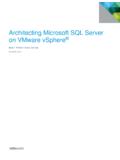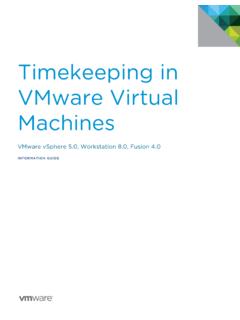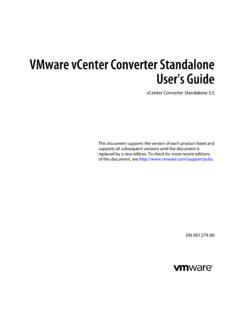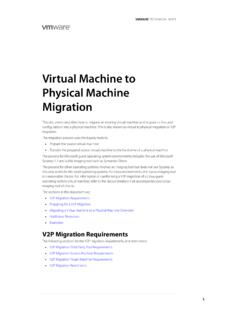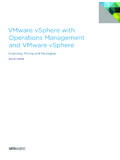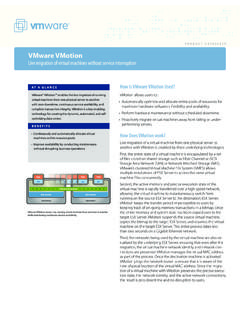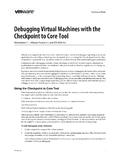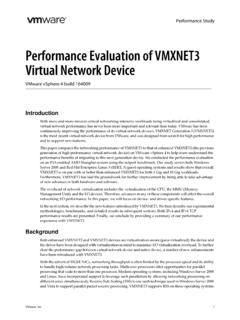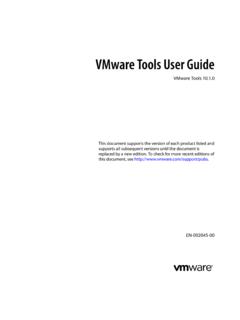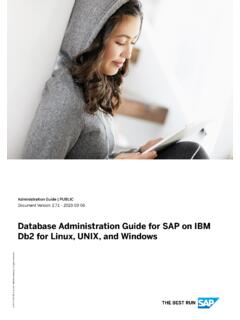Transcription of Using esxtop to Troubleshoot Performance Problems
1 VMWARE TECHNICAL TROUBLESHOOTING NOTE1 VMware ESX server 2 Using esxtop to Troubleshoot Performance ProblemsThe VMware esxtop tool provides a real-time view (updated every five seconds, by default) of ESX server worlds sorted by CPU usage. The term world refers to processes running on the VMkernel. There are three types of worlds:System: The worlds that are needed to perform various system services. These include one idle world per physical CPU that runs when there is nothing else to run on that physical CPU, helper worlds for performing asynchronous tasks and driver Console: The world for the service console.
2 It always runs on physical Machine: The world for each virtual CPU. This is the world you look at when troubleshooting. Also, esxtop displays information about the state of the physical server running an ESX server . It lists CPU utilization for each physical processor, memory utilization, and disk and network bandwidth for each network and disk device available to the ESX server machine. Fur thermore, esxtop lists CPU and memory utilization for each individual VMkernel world. Memory utilization is characterized by the type of memory (for example, shared, private, or swapped) that is being consumed.
3 These CPU and memory statistics let you monitor the resource utilization for each of your virtual following sections describe the process for troubleshooting a suspected Performance problem at the virtualization layer ( , the ESX server layer): Using esxtop on page 2 Other Tools on page 6 Using esxtop to Troubleshoot Performance Problems2 Using esxtop This section describes the necessary steps to Troubleshoot your ESX server machine Performance Problems Using esxtop . The steps are: Getting Started Starting esxtop Examining CPU Usage Assessing Memory Usage Assessing Disk and Network Usage Exiting esxtopGetting StartedDo the following before you start to Troubleshoot a problem Using esxtop :1.
4 Log on to the VMware Management Interface for the ESX server machine in question. Refer to the online document, Logging Into the VMware Management Interface, for details. In the status monitor, under Virtual Machines, note the virtual machine IDs (or VMIDs) for all virtual machines running on the server . Partial screen shot of the VMware Management Interface showing virtual machine IDs2. Make certain you have an secure shell (SSH) client. Windows users can get a free SSH client from ~sgtatham/ If you have ESX server version , refer to the VMware Knowledge Base Answer ID 1078 for instructions on downloading and installing the VMware Performance monitoring tools, esxtop and vmkusage.
5 ESX server version and higher include esxtop and vmkusage. See Using vmkusage to Isolate Performance Problems on page 6 for a description of esxtopPerform the following steps to start and set up Machine IDUsing esxtop to Troubleshoot Performance Problems31. Using a secure shell (SSH), log on to the ESX server machine as root. 2. Enter esxtop in the SSH command line . The esxtop display : The esxtop tool includes several interactive commands. To view a list of the interactive commands, enter Enter the f command .
6 The Field Select page Enter r to toggle on the SWPD esxtop to Troubleshoot Performance Problems45. Press any key other than a through x to see the esxtop display : You can also run esxtop in batch mode. For example, use the command :[root]# esxtop -b -n iterations > detailed command reference information, enter man esxtop on the SSH command line . Examining CPU UsageThis section describes how to assess system CPU loading, percentage of individual CPU use and individual virtual machine CPU Average LineExamine the load average on the first line to determine the amount of use for all physical CPUs on the ESX server machine.
7 The load averages are displayed for five-second, and one-, five- and fifteen-minute intervals. A load average of means that the ESX server machine s physical CPUs are fully utilized, and a load average of means they are half utilized. On the other hand, a load average of means that you either need to increase the number of CPUs or decrease the number of virtual machines running on the ESX server machine because the system as a whole is LineExamine the PCPU line for the percentage of individual physical CPU use for CPU0 and CPU1 respectively (for a dual-processor machine).
8 The last value is the average percentage for all of the physical CPUs. As a rule of thumb, is a desirable usage percentage, but bear in mind that different organizations have varying standards with respect to how close to capacity they run their servers. 90% should be considered a warning that the CPUs are approaching an overloaded esxtop to Troubleshoot Performance Problems5 You can enter the interactive c command to toggle the display of the PCPU line . If hyper-threading is enabled, the LCPU line appears whenever the PCPU line is displayed.
9 The LCPU line shows the logical CPU Machine CPU UsageA virtual machine world is listed as vmm in the WTYPE column. The world ID (WID) corresponds to the VMID in the VMware Management Interface Status Monitor (see Getting Started on page 2). For virtual machines with one virtual CPU (VCPU), the VCPUID and WID is the same. For virtual machines with two VCPUs, there are two VCPUIDs associated with one WID. For example:VCPUID WID WTYPE ..135 135 vmm ..136 135 vmm ..Use the WID and VMID values as cross references to identify a specific virtual machine s display name.
10 Use the following steps to assess virtual machine CPU Examine the %READY field for the percentage of time that the virtual machine was ready but could not get scheduled to run on a physical CPU. Under normal operating conditions this value should remain under 5%. 2. Examine the %USED field for the percentage of physical CPU resources used by a VCPU. If the physical CPUs are running at full capacity, you can use %USED to identify a virtual machine that is Using a large amount of physical CPU resources. 3. Examine the %EUSED field for the percentage of the maximum physical CPU resource usage a virtual machine is currently Using .
